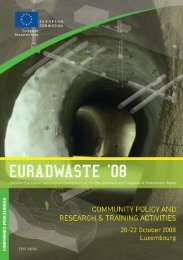EU industrial structure - EU Bookshop - Europa
EU industrial structure - EU Bookshop - Europa
EU industrial structure - EU Bookshop - Europa
You also want an ePaper? Increase the reach of your titles
YUMPU automatically turns print PDFs into web optimized ePapers that Google loves.
<strong>EU</strong> <strong>industrial</strong> <strong>structure</strong> 2011 — Trends and Performance<br />
FIgURE II.6: Large economies are less dependent on a few sectors<br />
8<br />
7<br />
6<br />
5<br />
4<br />
3<br />
2<br />
1<br />
0<br />
0 500 1 000 1 500 2 000 2 500<br />
42<br />
LU<br />
BG<br />
GR<br />
RO<br />
LV<br />
PT<br />
EE HU<br />
LT<br />
MT IE<br />
DK<br />
CY<br />
SK CZ<br />
SI<br />
FI<br />
SE<br />
AT<br />
BE<br />
NL<br />
PL<br />
Source: own calculations using Eurostat data.<br />
As explained in Box II.1, being highly specialised in a sector<br />
does not mean that the sector in question represents<br />
a large share in the economy. A sector in which a country<br />
is specialised represents, in proportion, more than in other<br />
countries. In certain countries, sectoral indexes reach<br />
very high values. The indices should be interpreted with<br />
caution. As indicated in the headings below every country<br />
abbreviation, data availability for the countries differs<br />
substantially in some cases. The latest data available for<br />
UK and Poland refer to 2005 and 2006 for Bulgaria. For the<br />
countries where data is available for 2009, the recent crisis<br />
may have affected the specialisation indices significantly<br />
compared to 2008: manufacturing of refined petroleum<br />
products illustrates this. The industry only accounted for 1.7 %<br />
and 1.9 % of Hungarian GDP in 2008 and 2009 respectively.<br />
The corresponding <strong>EU</strong>‑27 shares were 0.3 % and 0.2 %. Even<br />
though the industry declined in absolute terms in Hungary,<br />
the specialisation index increased from 5.5 to 8.5 since it<br />
declined less than the whole economy while the opposite<br />
occurred for the whole <strong>EU</strong>‑27.<br />
ES<br />
IT<br />
UK<br />
FR<br />
The highest sectoral level of specialisation is in Hungary,<br />
with a specialisation of 8.5 in refined petroleum products.<br />
Another high level of sectoral specialisation is found in<br />
Ireland with a specialisation of 6.0 in chemicals. Bulgaria<br />
and Romania show high specialisation in agriculture. These<br />
findings reflect the trend according to which the more<br />
developed a country is, the less important the primary<br />
sector becomes. For mining and quarrying, Bulgaria,<br />
Denmark and the Netherlands are the most specialised.<br />
The lowest specialisation in manufacturing can be found in<br />
Cyprus, Greece, Latvia and Luxembourg, with specialisation<br />
indices between 0.4 and 0.7. Luxembourg stands out as<br />
highly specialised in financial intermediation. Looking<br />
more closely at manufacturing sectors, a few facts are<br />
worth highlighting. The Baltic countries Estonia, Latvia and<br />
Lithuania are highly specialised in the wood industry with<br />
specialisation indices between 3 and 6. Italy still has a very<br />
high specialisation in leather, cf. Table II.2.<br />
DE
















